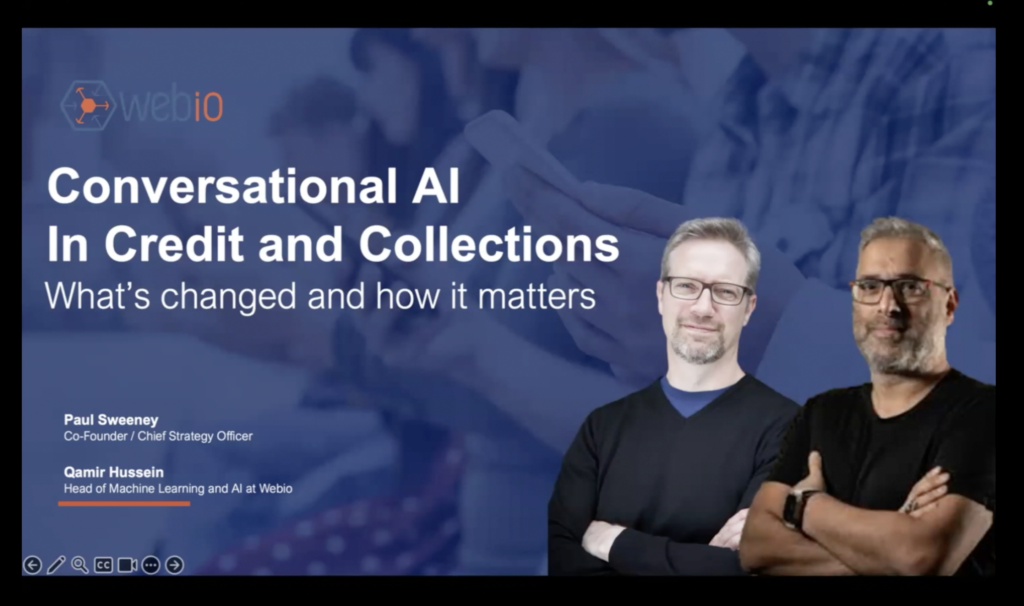Introduction
This is a excellent demo, and shows the power of crafting solutions for specific business problems using AI, which is a piece of the overall solution. Yes, the models will change as the technology rapidly improves. And the solution can evolve to take advantage of those improvements in LLMs (Large Language Model).
We’ve been tracking Webio’s evolution over the years. They have crafted a strong, defensible moat for conversations around debt.
Late payments are common, there are many reasons. Some people are consistently late, and money is an emotional issue for everyone. When people are consistently late, it’s often with multiple companies. The key first step is understanding why they are late and giving people options, empowering them to better manage the situation. Through understanding and offering options, a path out of debt can be found.
The key quote is, “Its not about getting debt out of the person, rather getting the person out of debt.”
Webio’s solution focused on:
- Precision in context (understanding the situation and options)
- Data driven (using customer data to help resolve the issue)
- Compliance by design (I think vCon can help here)
- Seamless integration (a solution, not an IT project with lots of stitching)
- Measurable impact (understand the value Webio creates)
Experience
Enzo runs through the experience of an agent, they have webchat and WhatsApp. WhatsApp’s popularity around the world makes it the default choice outside a few countries. Simply, its familiar and easy. Its branded, and all messages are customizable. Building off an existing proven workflow is always easier.
The example Enzo gives takes the path of an income and expenditure survey to work out the situation. He then reverts to an agent and their experience in context with the conversation the customer has had so far. In the agent view they can see the propensities and intents, and any that are flagged. This is all done in compliance with local regulations. And critically done in a human way. I see many companies in the AI-enhanced workflows / communications emphasizing the human aspect of the communications.
Enzo then throws in a mental health issues, in addition to Graham loosing their job. This is all flagged for the agent, and points to where in the conversation those vulnerabilities were mentioned. Paul points out the importance of the integrated solution in enabling such sensitive and complex conversations to be managed for successful outcomes.
Technology
Q then runs through the technology. This helps explain and justify why they control everything in the stack. It’s all about the data, sourcing, preparing, managing, and training. This has been raised in several presentations on voice agents at TADSummit. Without special effort and focus on the data, the usual GIGO (garbage in; garbage out) problems occur.
Webio use multiple models depending on the function, for example recognizing a date could be an intent engine. A specific customer could have additional requirements, that could change that function. They track and version control their stack, so on testing if there is a performance drop, they can back track.
Q makes an important point, they have a focused application, so generalizations are the opposite of their objectives. I think of it as keeping their stack at a performance sweet spot, by NOT adding too many capabilities / learning so everything tends towards the mean.
The 2 main tools Webio built are:
- Jupiter – metrics and quality
- Hopper – annotation and model management
Q reviews the architecture, Jupiter, Hopper, and how they maintain the quality of their solution. Its runs on the cloud in Europe, and is GDPR compliant. It’s great to see Webio’s complete solution, and how they’ve built a defensible moat. There are currently multiple approaches to managing LLMs in conversations, Webio is a focused example.


2 thoughts on “Revolutionizing Debt Conversations with Conversation Intelligence. Paul Sweeney, Qamir Hussain, and Enzo Viscito. Webio”
Comments are closed.